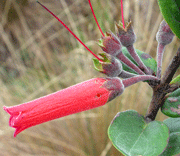James L. Luteyn and Paola Pedraza-Peñalosa
The New York Botanical Garden
|
|
Pellegrinia is a genus consisting of five species, endemic to central Peru. It is probably related to Siphonandra and is distinguished by filaments with a dorsal mass of short, retrorse hairs, a character unique in the Vaccinieae. |
Terrestrial or usually epiphytic shrubs, stems sometimes swollen at nodes; bud scales sometimes subulate. Leaves alternate, evergreen, coriaceous, pinnately or plinerved, margin entire or rarely shallowly crenate, short-petiolate. Inflorescence axillary, solitary or fasciculate, with 1-3 pedicellate flowers; floral bract inconspicuous; bracteoles 2. Flowers 5-merous, without odor; aestivation valvate; calyx continuous with pedicel; hypanthium obconical, terete or costate; limb subcoriaceous, suberect or spreading; lobes 5(-6); corolla subcylindric, subinflated, carnose, 2-5 cm long, the lobes 5(-6), short; stamen 10, equal, about equalling the corolla; anthers lacking disintegration tissue; filaments distinct, dorsally densely pilose with matted retrorse hairs, lacking spurs, shorter than anthers; thecae smooth; tubules elongate, thin, flexible, about half as wide as thecae, ca. 2-4 times longer than thecae, dehiscing by small flaring, terminal or oblique pores; pollen without viscin threads; ovary inferior; style slightly exserted; nectariferous disc annular. Fruit a spherical, blue-black berry.
Key to Neotropical Species Back to Top
A key and complete treatment is lacking, and thi synthesis comes from Luteyn's unpublished notes.
